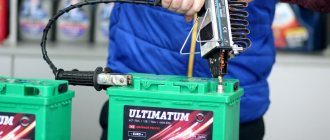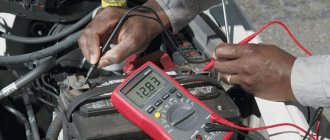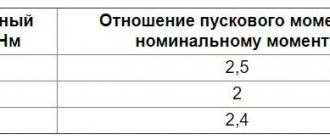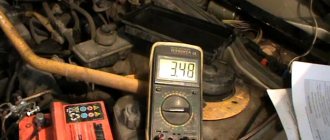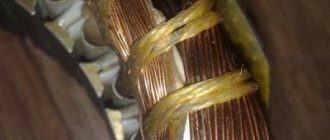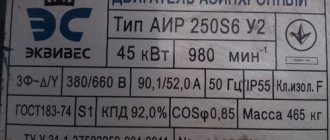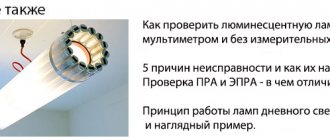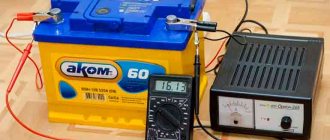So which battery is better to buy for a diesel engine so that there are no problems starting it in winter? When choosing, you should first of all pay attention to the basic parameters:
- Capacity is an indicator that informs about how long the battery is capable of delivering a current of 1 A. For diesel cars, it should be 10-15% higher than the same indicator sufficient to operate gasoline engines.
- Starting current is the maximum possible current that the battery produces during a cold start.
Both parameters must be taken into account when choosing a battery.
What happens if you put a smaller capacity battery in a car?
If you put
The battery
has a smaller capacity
than in the manual. The car
will
work. The factory manual indicates the minimum for the battery, which should be enough to operate the vehicle and all automatic components.
Interesting materials:
Where are the pictures stored for the account? Where to store aloe gel Holika Holika? Where is Viber backup stored? Where does chrome store bookmarks? Where is the basket on Meiza? Where is the Recycle Bin in Windows? Where to eat in Adler? Where is the best legal education in Russia? Where's the best coffee? Where is my account?
Starting a cold engine
The launch was carried out at a temperature of about 0 degrees. Mastech ms2108a current clamps were used to measure the current. The voltage on the battery before starting is 12.53 Volts.
The voltage at the battery terminals before starting a cold engine.
The starting current of the starter of a car with a cold gasoline engine. The current strength when starting a cold engine with the clutch depressed reached 270 Amperes.
How to find out the required indicator for a specific car
A diesel engine will require a higher starting current than a gasoline engine, since the compression level is significantly exceeded, up to 20 At.
Average parameters:
- diesel engine - 300 Ampere;
- on gasoline - 255 Amperes.
These values were measured at a temperature of -18°, and this most likely will not allow the car to start in colder conditions.
True, with the improvement of technology, indicators of 400-600 A are often observed in expensive car models.
Undoubtedly, it is necessary to find out the parameters of the car, but a value of 450-500 A is enough for any region of the Russian Federation.
The check is also carried out by special testers. The most famous:
- Midtronics;
- Bosch BAT-131;
- DHC.
The price of the measuring apparatus is 50-70 thousand rubles. An analogue from China can be bought for 10-15 thousand rubles. There are estimated deviations between cheap and expensive devices, but all measuring instruments can detect an “empty” battery. After all, such a generator has an indicator that is significantly less than the average error of the device, i.e. a small value of the indicator will immediately indicate a dummy. They have this value with a capacity of 60 Ah 300-400 A, and the lowest starting current of the starter for such a battery should be 470-480 A.
Starting current of car battery and starter
“What is the starting current of the battery and starter. How much current is needed to start a diesel engine?
When choosing a battery, buyers always pay attention to the magnitude of its starting current. Some believe that this is the current that the starter will consume if this battery model is used.
In the electrical circuit of the battery - starter, the battery has its own internal resistance (2-9 mOhm), the connecting wires and terminals have resistance (0.003 Ohm), and the starter itself (DC electric motor) also has internal resistance (insignificant at rest, and at the moment of rotation much higher). The starter, terminals, wires are resistors that limit the battery current in the circuit. There is also a voltage drop at the starter “resistor”. For powerful diesel starters, Rin is low (6-10 mOhm), for starters for gasoline engines it is higher (20-30 mOhm). Typically, the resistance of the starter and power wires should be 1.5-2 times greater than the internal resistance of the battery. This is necessary so that the voltage during startup does not fall below 9 Volts, which means that the operation of the ECU, sensors, and executive electronics of the car is not disrupted, in addition, so that too high a current is not supplied to the starter. As can be seen from the oscillogram in Fig. 2 at the beginning of the start (the starter is just starting to rotate and has almost no resistance R), the current in the circuit is 360 Amperes and the voltage at this moment is 8 Volts. If there was no resistance from the wires and the starter, then a current of 450 Amps and a voltage of 7.2 Volts would be recorded. Then the starter electric motor with a power of 0.8 kW begins to rotate and its Rin increases, the current in the circuit decreases, and the voltage increases. If we do not take into account the initial moment from 0 sec to 0.05 sec, then in our case the starting current at the starter is 150-100 Amperes and the voltage at this moment (before the car generator starts working) is 10-11 Volts.
The figure shows an oscillogram of voltage and current taken from the starter at the moment of starting a 1.5 liter gasoline engine. The battery has a capacity of 60 Ah with a starting current of EN 450 A. In this case, starting the engine took 1.2 seconds. During this time, the engine managed to spin up to 200 rpm with the starter. The current graph is red (unit Ampere). The voltage graph (unit Volt) is colored blue.
To begin independent operation of a car engine, it is necessary to create an initial or starting speed for it, i.e., start the engine. The starting speed depends on the type of engine: 40 - 70 rpm for gasoline engines and 100-200 rpm for diesel engines. Therefore, to start, you need to spin the shaft to at least 40 rpm in a gasoline engine and up to 100 rpm in a diesel engine. Modern starters spin the crankshaft to a speed of 180 rpm within a second.
The current needed to start the engine using a starter is called starting current. The current written on the battery label is called cold cranking current. TCR is the maximum battery current when only the internal resistance of the battery is taken into account in the circuit. With a discharged or old battery R ext. higher, which means TCP lower. The starting current will always be less than the cold cranking current, since 2 resistances are added to the electrical circuit: power wires and the starter. That is why it is important to monitor the cleanliness of the terminals and the condition of the power wire connections. “Additional” resistance in the battery-starter system will worsen the start.
The graph shows the characteristics of a starter designed to start VAZ 2101-2107 engines with a rated power of 1.6 kW. The graph shows the dependence of rotation speed, power and torque on current consumption. Legend: M - starter torque, P - starter power, n-turns of the starter armature, U-voltage, I - cold cranking current. The diagram shows that at idle the starter has maximum speed, but the torque and power are zero. And when the armature is fully braked, the current and torque increase, and the power is zero. For a good start (in this example), the following conditions must be met: the torque of the starter must be higher than the moment of resistance of the engine, while the starter speed must be 10-20 times higher than the engine starting speed, the voltage must be about 9-10 Volts and the cold cranking current must be batteries 450-550A. From the graph you can also understand that installing a battery with a cold cranking current of 700A or higher on a VAZ-2107 will not improve engine starting. Also, installing a small battery with a THP 300A will make starting the engine difficult.
Figure 4 shows the characteristics of a 0.9 kW starter. A starter of this power starts gasoline engines up to 1.6 liters in many modern cars. Different models have different characteristics, but in general they are the same.
Starters for gasoline engines have a power of 0.8-1.4 kW, and for diesel engines 2 kW or more. Starter power is indicated based on current consumption at idle speed of 4000 rpm. The rated current consumption of a 1 kW starter is 80 Amps, and 2 kW is 160 Amps. Most of the energy must be spent on overcoming the state of rest of the motor. At the moment of starting, the starter shaft is braked by the load (the engine being started). In practice, the starter at the beginning of the start (hundredths of a second) consumes a current that can be 7-10 times higher than the rated current, then in tenths of a second a current that is 2-4 times higher than the rated current. Then the starter, having gained speed, continues to “turn” consuming its rated current. After 0.8-1.2 seconds, a serviceable engine is already started. For example, to start a working 1.5 liter gasoline engine. with a 1 kW starter, the starting current is an average of 150 Amperes. Starting current for 1.5 l diesel engine. — 300 A (starter 2 kW).
When testing starters, a resistance load is used, at which the starter shaft is completely inhibited and the starting current reaches its maximum value. For a 1 kW starter, max starting current is 700 A, and for a 2.4 kW diesel starter, max starting current = 1500 Amperes.
Hot - cold engine start. A “hot” engine, in which there is fuel in the injectors, the spark plugs are dry, and the oil is heated to operating temperature, will start in a short period of time, sometimes in less than a second. Winter morning start-up will be longer since the resistance to rotation of the frozen motor shaft will be higher (more viscous oil).
With an increase in the current supplied to the starter motor, the heating of the windings increases. Large overload with high starting current leads to overheating of the starter motor windings, and there is a risk of failure. Starter manufacturers do not recommend starting attempts longer than 10 seconds. The breaks between engine starts should not be shorter than 1 minute. Cooling system for starters. absent.
The starting current of the starter directly depends on the load on the shaft - mainly on the engine volume and its compression ratio. The load inhibits the starter from spinning up to rated speed and reaching the rated internal resistance, which will reduce the current. The load size is affected by the type of engine: gasoline or diesel, its condition, age, design. Knowing the amount of starting current in your car makes it much easier to choose the right starter battery.
The starting current (cold cranking current), which is indicated on the car battery, is the current that a fully charged battery can supply within 30 seconds. The starting current of a car battery depends on the total area of its electrodes. In practice, a battery with a large number of plates, and as a result of greater weight and larger size, has a higher cold cranking current.
Important! If the battery is discharged or old, or the “battery-starter” pair is incorrectly selected, then when the engine starts, the voltage in the network will drop below 7-8 Volts. In this case, there may be problems with spark generation or the ECU may reboot (or shut down), as a result of which the start will not take place. Computer diagnostics of electrical equipment: battery, starter, generator using a motor tester.
Increased battery performance
Today, starting values need to be divided into devices for diesel engines and gasoline engines. Indeed, in diesel engines, the starter voltage indicators are much higher than in gasoline engines, since the compression in the air cylinder is much higher and can reach up to 20 atmospheres.
Therefore, you can focus on averages:
- in gasoline engines 250 atmospheres;
- in diesel engines - 300 atmospheres.
Today in stores you can find batteries with starting power ratings of even 600 amperes. Many people worry about this because they can burn the starter with such voltage. But in this case there is no need to worry. It is impossible to burn the starter in this way, and if possible, it is better to take a more powerful battery and forget about how difficult it is to start in severe frosts.
Everything is clear about the starter here. This will not damage it in any way, but will only increase the speed when starting, which, in turn, will lead to a quick and high-quality start of the engine. Therefore, do not be afraid if the starting current of the battery is higher than the standard one.
Of course, you need to take into account the characteristics of the car, but a starter current of 300-400 amperes will be enough for almost all regions of the country. This applies to passenger cars.
Why do you need to know the starting current of the starter?
First of all, in order to choose the right battery if it’s time to replace the old one. If you don’t pay attention to this parameter, chasing an attractive price or ampere-hour capacity, you may encounter the fact that the new battery will not be able to crank your starter normally, or will not budge it at all.
As a rule, on all modern car batteries this characteristic is indicated under the guise of maximum starting current. That is, at first glance, there should be no difficulties with the choice. However, there are several nuances here. Let's look at them.
- Firstly, it must be taken into account that the maximum starting current indicated on the battery case can only be delivered in a fully charged state. That is, when the new battery one day turns out to be discharged for one reason or another, for example, by half, the starting current that it will be able to produce will decrease.
- Secondly, the maximum starting current indicated on the case will steadily decrease with each day the battery is used. So, if new and fully charged it is capable of delivering 400 A (as written), then after six months this characteristic may decrease to 300 A, and so on.
- Thirdly, it would not be amiss to remember that some exaggerate the characteristics of manufactured products. This means that with the 500 A indicated on the case, the maximum starting current will actually not reach this figure. In some cases, measurements showed that this parameter was as much as twofold. Fortunately, such cases are rare today. But we need to remember them. There are special electronic devices to check the true maximum starting current of the battery.
Further, it is necessary to take into account that the car is not always operated under the same conditions and in ideal technical condition. This means that the battery must be selected with a reserve in terms of starting current - the more, the better.
Some car enthusiasts have a misguided fear that the excessively high starting current indicated on the battery will burn out the starter. This is wrong. The starter will never take more current than it needs. So, if the battery says that the maximum current is 600 A, this does not mean that exactly this current will go to the starter. No. He will only take “his” prescribed 150-200 A.
This concerns the choice of battery. However, knowing your starter's inrush amps is useful for other purposes as well. Including increased energy consumption, it is possible to promptly identify some problems with the machine. If the starter current consumption has increased, this may indicate wear, clogging, short circuits in the windings, poor contact and other breakdowns. By eliminating these shortcomings in a timely manner, you will reduce the load and wear of the battery. Accordingly, it will last longer, and the engine will start easier even despite severe frosts.
Classifications in the world
As already mentioned, the starting power of car batteries can vary significantly. They also have their own methods and methods for determining current, as well as marking. First you need to know how they are indicated by different manufacturers.
To mark starting power use:
- Germany has its own designation system - DIN;
- in the USA they indicate SAE;
- in Europe (except Germany) they are marked EN;
- in post-Soviet countries, “starting or starting current” is often indicated.
In any case, even if such indicators are not directly on the battery itself, they must be in the service book that comes with it. You can also ask the store clerks about this.
It is also necessary to analyze the methodology for determining the strength of the starter current in different countries:
- in Europe they are placed in a temperature of minus 18 degrees and discharged to 7.5 volts for 10 seconds;
- in Germany they also lower the temperature to minus 18 degrees and lower the voltage to 9 for 30 seconds;
- in Russia the system is identical to the German one, the GOST rules are no different;
- in the USA they lower it to 18 degrees below zero and discharge it to 7.2 volts for 30 seconds.
As the voltage decreases, more amps are required. This, in essence, is an imitation of starting a car engine. The temperature is lowered to artificially create operating conditions at low temperatures.
Basic Concepts
First, let's look at a few basic concepts in order to better understand what the inrush current of a car starter is and not confuse this value with other characteristics.
A car starter is nothing more than a DC electric motor. This means that it does its job (turns the engine crankshaft) by consuming electrical energy stored in the battery. This energy is characterized by several quantities - voltage, current and power.
The voltage at which a loaded passenger car starter operates is in the range of approximately 11-13 V. What does loaded mean? If the starter is removed from the engine and connected to a current source without any load, then it will operate at a much lower voltage. However, when installed on a car, it usually does not work at a voltage of less than 11 V. This is well known to those car enthusiasts who have had a worn out or completely discharged battery.
The current consumed by a loaded passenger car starter varies in the range of 100-500 A. Here, as in the case of voltage, the load plays a big role. If the starter is connected to a power source separate from the engine, then it will consume much less current. It follows from this that the greater the load on the starter, the more current it will consume.
The power of a starter is a quantity that depends on the voltage at which it operates and the current it consumes at a particular moment in time. So, for example, if the starter of your car at a voltage of 12 V consumes a current of 150 A, then its current power is 12 × 150 = 1800 W.
From all this we can derive the following concept, which is important for motorists. What happens when the battery is worn out or weakly charged? What happens is that when the starter is operating, the voltage on it drops, for example, to 10.5 V. This means that if the starter consumes the same 150 A, then its power under such conditions is no longer 1.8 kW, but only only 1.5 kW. Accordingly, he turns the crankshaft sluggishly, or he does not have enough power at all to move it.
In addition, the greater the voltage drop that occurs at the battery terminals, the less starting current it is capable of delivering. It follows that our starter is no longer using 150 A, but two or three times less. This leads to a sharp decrease in power, which is not enough to turn the engine crankshaft.
For some car enthusiasts, another characteristic of the starter will be interesting. It shows the amount of energy he used while starting the engine. It can be measured in A*h (ampere-hours), and as we remember, it is in these units that the battery capacity is indicated. This means that by the starting current and operating time of the starter we can find out how much it has discharged our battery.
Let's look at the same starter. Let's say that during all his work, he, consuming a current of 150 A, started the engine on the first try, rotating it for 5 seconds. Now we need to convert seconds into hours, since we are interested in ampere hours. 5 seconds is approximately 0.0014 hours. Accordingly, our starter “took” 150 × 0.0014 A*h from the battery, that is, approximately 0.21 A*h. And this is with a capacity of 50-60 Ah.
But here it should be understood that we have considered simplified conditions. So, at high current consumption, the battery drains a little more than can be calculated on paper. In addition, the engine does not always start the first time, and so on. From all this, it is important to learn the following. If the starter was unable to turn over due to a weakened battery, then most likely it was not the A*ch that was praised, as many people think. He did not have enough starting current, since a discharged or damaged battery is not able to produce such high currents.
How to reduce the current when starting a car.
1. It is advisable to start the car at above-zero temperatures. To do this, it is advisable to warm up the car first if possible. For example, in a closed garage and the presence of an outlet, you can use a household heater to warm up the engine compartment. Do not heat your car with open fire under any circumstances - this is very dangerous. fuels and lubricants used in a car can cause a fire. When parking your car, it is also advisable to choose a warmer place for your car, if possible. Let's say behind an obstacle (fence), in the corner of a building, or in a planting.
The car engine, as well as the engine compartment, cools down even in very severe frosts in less than an hour or even two.
So it will take several hours for the oil inside the engine to completely freeze, which is heated up to 90 degrees when the engine is running. Therefore, if you come to work and are planning to go somewhere again at lunchtime, a warm engine will help you save time, and if the battery is bad, it will even help you out if your engine does not start the first time.
A few words about the structure and properties
Batteries were created specifically to recharge and start the car, that is, they are very practical from the point of view of operation. A regular battery discharged very quickly, and it was expensive to change it; that’s when batteries were invented.
Through trial and error, batteries evolved - so a few years after the invention, a very specific model emerged, this was about 100 years ago, which has not changed until now.
Usually these are six compartments with plates made of lead (negative) and its oxide (positive), which are filled with a special electrolyte made of sulfuric acid. It is this combination that makes the battery work; if one component is excluded, the operation will be disrupted. One scattered battery generates an average of 2.1V, this is extremely little to start the engine; in an average battery, they are combined by connecting them in series, usually 6 banks of 2.1V = 12.6 - 12.7V. This voltage is enough to excite the starter winding.

